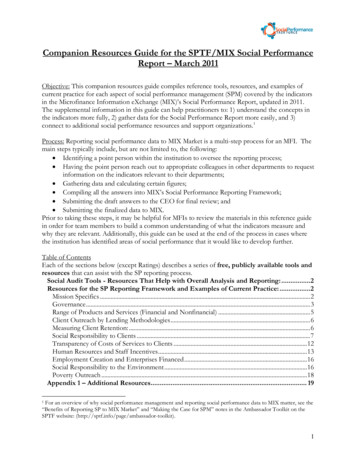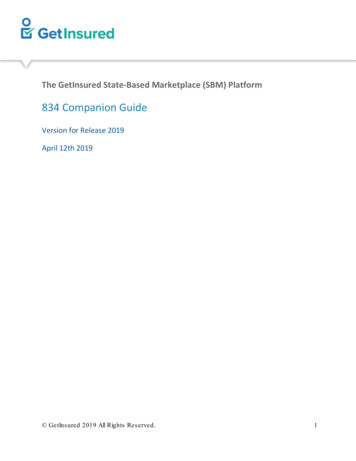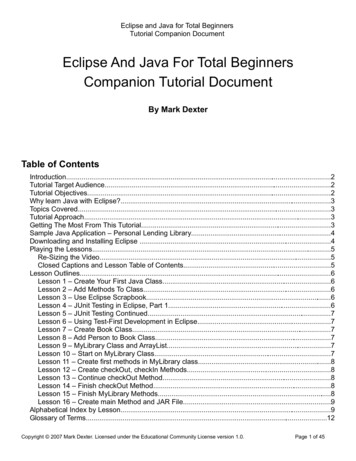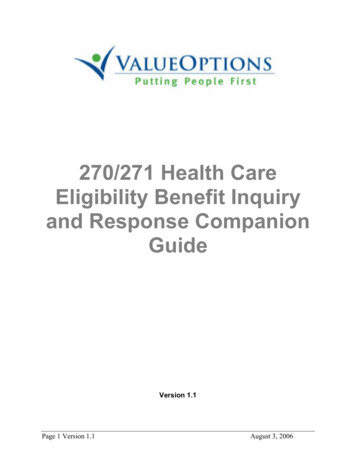
Transcription
Companion Resources Guide for the SPTF/MIX Social PerformanceReport – March 2011Objective: This companion resources guide compiles reference tools, resources,, and examples ofcurrent practice for each aspectpect of social performance management (SPM) covered by the indicatorsin the Microfinance Information eXchange (MIX)’s Social Performance Report,, updated in 2011.2011The supplemental information in this guide can help practitioners to: 1) understand the concepts inthe indicators more fully, 2) gather data for the Social Performance Report more easily, and 3)connect to additional social performance resources and support organizations.1Process: Reporting social performance data to MIX Market is a multi-stepstep process for an MFI. Themain steps typically include, but are not limited to, the following: Identifying a point person within the institution to oversee the reporting process; Having the point person reach out to appropriate colleagues in other departments to requestinformation on the indicators relevant to their departments; Gathering data and calculating certain figuresfigures; Compiling all the answers into MIX’s Social Performance Reporting Framework;ramework; Submittingting the draft answers to the CEO for final review; and Submitting the finalizedized data to MIX.Prior to taking these steps, it may be helpful for MFIs to review the mamaterialsterials in this reference guidein order for team members to build a common understanding of what the indicators measure andwhy they are relevant. Additionally, this guide can be used at the end of the process in cases wherethe institution has identified areas of social performance that it would like to develop further.Table of ContentsEach of the sections below (except Ratings) describes a series of free, publicly available tools andresources that can assist with the SP reporting process.Social Audit Tools - Resourcesrces That Help with Overall Analysis and Reporting:Reporting . 2Resources for the SP Reporting Framework and Examples of Current Practice: . 2Mission Specifics . 2Governance . 3Range of Products and Services (Financial and Nonfinancial) .5Clientient Outreach by Lending MethodologieMethodologies . 6Measuring Client Retention: . 6Social Responsibility to Clients . 7Transparency of Costs of Services to Clients .12Human Resources and Staff Incentives .13Employment Creation and Enterprises Financed .16Social Responsibility to the Environment .16Poverty Outreach .18Appendix 1 – Additional Resources. 191For an overview of why social performance management and reporting social performance data to MIX matter,matter see the“Benefits of Reporting SP to MIX Market” and ““Making the Case for SPM”” notes in the Ambassador Toolkit on theSPTF website: page/ambassador-toolkit).1
Social Rating with Field Survey .19Gender / Outreach to Women .19Market Research .20Appendix 2 – Social Audit Services for a Fee . 20Social Audit Tools2 - Resources that help with overall analysis and reporting:reportingSocial audit tools provide guidance on how to collect and interpret social performance data.The SPI Tool by CERISEThe SPI tool is a standardized audit tool that can be internally or externally administered and focuseson process management, an MFI’s stated objectivesobjectives, and how effectively its systems achieve them.The SPI analyzes social performance using a wide range of indicators, many of which are linked tothe Reporting Framework. The indicators in the SPI are grouped under four dimensions: Outreach to the poor and excluded populations, Adaptationdaptation of products and services for targeted clientsclients, Economicconomic and social benefits for the clientsclients, and Social responsibility to staff, clientsclients, and community/environment.The SPI report generates an analysis of the MFI’s social performance based on these fourdimensions. The report is an ExcelExcel-based tool, and answers can be presented as radar and diamondgraphs that give a visual depiction of an MFI's social performance. Analysis of results can be carriedout via discussion with an MFI’s management and other interested stakeholders. MFIs usingCERISE’s SPI social audit tool will soon be able to provide their social performance coredata to MIX without any additional effort. MIX and CERISE are working together tointegrate the SP indicators into the SPI questionnaire, so that a Social Performanceerformance Reportwill be automatically generated frfrom a completed SPI questionnaire. For a sample report ormore information contact: cerise@cerisecerise@cerise-microfinance.org or visit: Resources for the Social Performance Reporting Framework and Examples ofCurrent Practice, by Indicator CategoryCategory:CATEGORY 1: MISSION SPECIFICSResources:1. MFC’s From Mission to Action: Strategic Management ToolkitThis document guides practitioners through the process of developing a strategy map(develop and communicatenicate a clear social strategy), setting measureable social goals,goals and2 Three other Social Audit Toolss can be externally administered for a fee: EDA Rural Systems’ Social PerformanceAssessment (SPA), MicroFinance Centre’s Quality Audit Tool (QAT), and MicroSave’s Social Performance Management(SPM) Toolkit. See Appendix 2 for further details.2
implementing an action plan for the achievement of these social goals. The full ToolkitToisavailable here: ndStrategicMgtofMission.pdf2. Putting the ‘Social’ Into Performance Management: A PracticePractice-basedbased Guide forMicrofinance by Imp-ActAct Consortium and MFCThis guide helps MFIs shape their performance management systems to be more clientclientfocused. Key lessons learned about SPM include:: clients are at the center of SPM; balancedperformance management responds to clients’ vulnerability; and use of information is at theheart of performance management. This paper can be found emplate.rc/1.9.30447/3. Imp-ActAct SP Practice GuideThe Practice Guide offers step-by-step guidance on viewing performance managementthrough a social lens. The guide includes case examples, key issues, practical tips, andresources. The Guide is available for download in English, Spanish, Arabic, and French.Section 2.3 discusses mission, goalsgoals, and acticeguide.htmlExamples from Current PracticePractice:Mission statements should clarify the organization’s target market and development objectives.Statements that are too vague or sweeping are less effective in focusing the organization aroundconcrete social goals.1. CUMO Microfinance Limited ((Malawi)’s mission is “too take relevant, affordable and valuablefinancial services to rural people, particularly targeting women and the poor.poor.” In alignment with thismission, CUMO’s overall strategy does focus on reaching rural areas, women, and the poor.poorFurthermore, to create services that are “relevant, affordable and valuablevaluable,”” CUMO focuseson maximizing client satisfaction by balancing prodproductuct design and cost of services.services2. Pro Mujer’s mission is “toto provide Latin America’s poor women with the means to build livelihoods forthemselves and futures for their families through microfinance, business training, and healthcare support.”support Inpractice, Pro Mujer works in five different Latin American countries and is known for itsintegrated services. Through a combination of internal programs and externalcollaborations, Pro Mujer does provide clients with access to a wide range of microfinancemicrofiproducts, business training, and health services, as laid out in its mission.3. SHARE Microfinance Limited (India)(India)’s mission is “too mobilize resources to provide financialservices and support services to the poor, particularly women, for viable producproductivetive income generation enterpriseenabling them to reduce their povertypoverty.” SHARE uses studies to monitor whether its actions followits mission. For example, the SHARE’s website notes that an International Food PolicyResearch Institute study found that “about 85 per cent” of SHARE’s clients do in factbelong to the bottom most segment of the poor, and that further studies have found that“76 per cent” of SHARE’s members have experienced poverty reductionreduction.CATEGORY 2: GOVERNANCEResources:1. SEEP Progress Brief on SP and GovernanceThe SEEP Progress Brief recognizes that MFIs have multiple objectives and stakeholders,stakeholders soSP Governance must take a holistic approach to strategic and operational decision making.makingThe Governance assessment process begins with a social audit, continues with a special3
analysis of governance, and concludes with a plan to improve practices. The Progress Briefis available here: g/IMG/pdf/progbrief5 02.pdfmicrofinance.org/IMG/pdf/progbrief5 02.pdf2. Paper on Integrating SPM into Microfinance Capacity Building: GovernanceThis paper presents governance as the starting point for good SPM, expanding the definitionof fiduciary responsibility ttoo include protecting the MFI’s reputational assets as well. Thearticle provides definitions of governance broadly, but focuses on the role of the Board inclarifying the mission, endorsing a code of conduct, tracking performance (both financialand social),l), and balancing tradetrade-offs for a double bottom line. This paperaper is available Z7rUaUMWergfJkoe4M/SPMandGovernance.docx3. Imp-ActAct SP Practice GuideThe Practice Guide offers step-by-step guidance on looking at performance managementthrough a social lens,, including case examples, key issues, practical tips, guidance andresources. The Guide is available for download in English, Spanish, Arabic, and French.Section 2.4 discusses acticeguide.html4. MicroSave toolkits on GovernanceThe toolkits provide insight into the importance and implementation of good practice withrespect to Board governance, business planning, and strategic marketing. These toolkits areavailable here: http://www.microsave.org/toolkits/2/25. MicroSave Briefing Note #90: Integrating Social Performance Management intoGovernance of MFIsThis Briefing Note discussesiscusses the importance of integrating social performance into thegovernance framework of MFIs and practical strategies to do so. The document is availablehere: http://www.microsave.org/briefing notes/briefinghttp://www.microsave.org/briefing -of-mfisExamples from Current PracticePractice:1. AMK (Cambodia) has deeply integrated social performance into its governance structureand activities. This is evident in the balance of development and banking expertise onAMK’s Board, the Social Reporting Framework that AMK has developed and uses tomonitor social performance and report it to the Board, and the existence of a SocialReportingeporting Committee that overseeoverseess social performance efforts and has an advisory role tothe Board. See the Imp-ActAct case study on AMK,, which includes a table displaying the SocialReporting Framework: [willwill be posted soon here: ntre.net See alsoAMK’s annual report, page 17, for an organogram: [willwill be posted soon cecentre.net].2. Ahon sa Hirap Inc. (ASHI) (Philippines) ASHI has a defined leadership path to trainclients and advance them into positions of increasing responsibility within the organization,ending at Board RepresentativeRepresentative. By having clients participate in decision-makingmaking on productpolicy and development, ASHI ensures that focus remains on serving clclientient need. See thiscase study on ASHI: [willwill be posted soon here: ntre.net]3. Fundación Mujer scored 100% in the CERISE SPI category “client representatives.” Withthree client representatives on the Board of Directors, Fundación Mujer’s governancestructure gives clients a strong voice and influence in decisiondecision-making, policies, andorganizational strategy. Clients also have ready access to the full administrative team,4
including the Executive Director. See the following case studydy on Fundación Mujer: [will beposted soon here: re.net].CATEGORY 3: RANGE OF PRODUCTS AND SERVICES (FINANCIAL AND NON FINANCIALFI)Resources:1. MicroSave’s Product Design toolkitsThe Toolkit contains several component toolkitstoolkits: product pricing, pilot testing, product rollrollout, and marketing. These toolkits givgive MFIs the information and materials they need todesign products that are a good fit for their clients. These toolkits can be found www.microsave.org/toolkits/2/16. MicroSave also has a “Productoduct DevelopmentBooklet” from its Optimizing Performance and Efficiency series available at:http://www.microsave.org/briefing notes/producthttp://www.microsave.org/briefing notes/product-development-booklet2. SEEP’s Technicalnical Note on Providing Valuable ServicesThe Note offers advice on the role of associations in supporting innovations in productdesign for their member MFIs. It also provides a framework for the product design processand case examples for the stages of product innovation, design, and roll s/Innovation mar2010 web.en .pdf3. Grameen Foundation’s ppublication,ublication, “Microfinance: A Platform for Social Change”ChangeThis paper makes the case for “the potential of microfinance to serve as a platform forlaunching complementary approaches to addressing the needs and opportunities facing poorfamilies,lies, particularly their health and educational attainment.” It explores the main inhibitorsto microfinance clients’ success, and discusses how integrated services can increasemicrofinance’s reach and efficacyefficacy: http://www.community-wealth.org/ pdfs/articleswealth.org/ -magner.pdfExamples from Current PracticePractice:Financial:1. CUMO Microfinance Limited (Malawi) has a good track record of modifying financialproduct offerings in response to client need. An example is its launch of funeral benefitinsurance,, which CUMO offers through partnership with NICO LIFELIFE. For credit products,CUMO offers a variety of enterenterprise and agriculture loans: the Masika loan,, a relatively smallloan that offers client lower interest rates on subsequent loan cycles, the FUMBA loan, anagricultural loan designed to be disbursed at the beginning of the rainy season, a solidaritysolidaritygroup based loan called Kasupe, available to graduated clients, and a relatively large loan,Mtenthandevu, for small-holderholder tea growersgrowers. CUMO has demonstrated that it will modifyits product policies (e.g., fortnightly to monthly payments, reduction in interest rates in latercycles of Masika) based on studies of product effectiveness. See the following case study onCUMO Microfinance Limited: [will be posted soon here: ntre.net]2. FIS (Argentina) scored high on the SPI for adaptation of services to meet client need. Itsrange of loan products includes productive individual loans, productive group loans, homeimprovement loans, preferred loans, “opportunity” loans, and even special loans during thethholiday season. FIS even has a product for the financing and installation of solar screens.FIS also offers flexibility repayment schedules determined on a client by client basis. See thefollowing case study on FIS: [will be posted soon here: ].3. BASIX Group (India) iss a holding company of several microfinance institutions in Indiawith a mission to promote sustainable livelihoods for its clientsclients. The BASIX Group offersan extensive line of products and services, lending primarily for on- and off-farmoffenterprise5
activities, consumer credit, savsavings, and insurance. The Group has diversifiedied its services bygeographic region, sector,ctor, and market segmentsegment. See page 20 in the following USAID reportfor a case study on BASIXBASIX: [will be posted soon here: ntre.net]Nonfinancial:1. Pro Mujer Bolivia provides integrated services to women who live in conditions ofsocioeconomic exclusion. These services combine provision of credit with health servicesand training focused on health education and business development. Additionally, PMB hastraditionally sought to form alliances with local service providers to increase their clients’access to non-financialfinancial social development services, especially in terms of health,empowerment and citizenship training. See the following case study on Pro Mujer Bolivia:[willwill be posted soon here: http://spmresourcecentre.net].2. Sambandh (India) offers health camps through the Rural Resource Development Centre(RRDC),, distributes items to clients such as malaria nets, and provides scholarshipopportunities for the children of clients through the Life Insurance Company of India (LIC).It also has set up a client helpline and taken steps to ensure that clients really dod use andbenefit from the helpline, including training staff to operate the helpline, supervising callsand actions taken in response, and communicating with clients to be sure they arecomfortable with the helpline. See the following case study on SambaSambandh: [will[be postedsoon here: tre.net].3. Fonkoze’s approach involves a series of four complementary programs and products thatFonkoze calls “Staircase out of Poverty.” The first step in the staircase, Chemen Lavi Miyò(CLM), or Pathwayway to a Better Life, is an 1818-month program compriseded of onlyon nonfinancialservices and designed to help the poorest of Fonkoze’s clients build the assets, skills, andconfidence they need to begin the journey out of extreme poverty. In the next step, TiKredi,TiKclients receive a small loan but also intensive business and life skills training.training Fonkoze alsosupports all clients with an education and literacy program and a health program. SeeFonkoze’s 2009 Annual Report:http://fonkoze.org/docs/Fonkoze 2009http://fonkoze.org/docs/Fonkoze 2009 Social Performance Report Final.pdf.Social Performance Report Final.pdf.CATEGORY 4: CLIENT OUTREACH BY LENDING METHODOLOGIESNo particular resources are needed here, as data for the three social indicators in this categoryshould all be directly available from an MFI’s management information system: Number of clients Number of clients with individual loans Number of clients with group loansCATEGORY 5: MEASURING CLIENT RETENTIONResources:1. MFC’s Spotlight Note 11 on Client Desertion - a Microfinance Plague: How toDiagnose It Successfully?This article examines the reasons for client exit, presents the main formulas for calculatingclient dropout rates, and presents client exit indicators that MFIs can use to understandclient motivations, product design and costs. The article is available /MFC SN11 eng.pdf?PHPSESSID c0f8be95ec7659b062e608a9898912d36
Followed by two case studistudies: Promoting Client-focused Organization - Partner's Exit MonitoringSystem, MFC Spotlight Note #9 available C SN09 eng.pdfand Beyond Numbers: Prizma's Exit Monitoring SystemSystem,, MFC Spotlight Note #10 available C SN10 eng.pdf2. Imp-ActAct Consortium’s PractiPractice Note on Client ExitThis article defines client exit, provides formulae, and discusses how to measure exit, why itis important, and what MFI’s can learn from their exit data. Case examples are providedthroughout. The Note is available here:http://www2.ids.ac.uk/impact/files/practice notes/PN3 Exits.pdfExamples from Current PracticePractice:1. Fonkoze has made a strategic decision to focus on client retention. One key driver of thiswork is the Social Performance Monitoring and Market Research Department, the backboneof which is the team of researchers, called Social Impact Monitors (SIMs), who work fullfulltime in branches throughout the country and systematically capture client data. Amongother activities, SIMs lead regular focus group discussions in order measure clientsatisfaction in all centers and conduct exit interviews with all exiting cclients. Furthermore,SIMs have made the data they collect useful; the reports they produce generate discussion ofkey issues and lead to action. SIMs have also demonstrated success in building relationshipswith difficult clients and bringing back exiting clients. Additionally, Fonkoze hasincorporated client exit into its staff incentive scheme. See Fonkoze’s 2009 SocialPerformance Report:http://fonkoze.org/docs/Fonkoze 2009http://fonkoze.org/docs/Fonkoze 2009 Social Performance Report Final.pdfSocial Performance Report Final.pdf.2. Prizma (Bosnia-Herzegovina)Herzegovina) is committed to exit monitoring. It uses a short, semisemistructured interview, conducted on a sample basis by field staff twice a year, to answerquestions such as what characterizes those who are leaving, how many are leaving, and why?whyThe head office analyzes results for trend analysis and branch comparisons. It also minesexit data to inform strategic planning. Additionally, Prizma conducts client satisfactionmonitoring twice a year. See the following case study on Prizma: [will be posted soon cecentre.net].3. AMK (Cambodia) has high client satisfaction: 86% of new clients and 87% of old clientsprovide positive feedback. AMK has a strong internal research team which, among otheractivities, monitors client exexit.it. The research team also has developed an index of householdwellbeing to use for poverty assessment of client households and impact monitoring, butalso uses this survey to cover any client who exits AMK. See the following case study onAMK: [will be postedosted soon here: http://spmresourcecentre.net].CATEGORY 6: SOCIAL RESPONSIBILITY TO CLIENTSResources:1. The Smart Campaign ToolsThe Smart Campaign is a global movement to promote the ethical treatment of clients byraising awareness of the principles of client protection and providing tools and resources toaid in their implementation. There is a Questionnaire for selfself-assessment, a Guide thatdescribes the process of external evaluation, and a webinar training series that includes anoverview of Client Protection and an introduction to the principles. These tools can befound at: .org/tools-a-resources7
2. Imp-ActAct SP Practice GuideThe Practice Guide offers step-by-stepstep guidance on looking at performance managementthrough a social lens, including case examples, key issues, practical tips, guidance andresources. The Guide is available for download in English, Spanish, Arabic, and French.Section 3.8 discussesses client protection and iceguide.html3. MicroSave’s Customer Service ToolkitThe customer service toolkit can help an MFI measure how clients are currently treated; italso provides a framework that the MFI can implement to ensure the institution willcontinue to be client centric. The Toolkit is available tExamples from Current PracticePractice:The Smart Campaign has identified six client protection principles that any institution, regardless ofits mission, should adopt in order to do no harmharm:1. Avoidance of Over-IndebtednessIndebtedness2. Transparent and Responsible Pricing3. Appropriate Collections Practices4. Ethical Staff Behavior5. Mechanisms for Redress of Grievances6. Privacy of Client DataThe section below provides examples of current practice in each area.1. Avoidance of Over-IndebtednessIndebtednesso BancoSol (Bolivia) developed an early warning system in conjunction with thenational regulator and the credit bureau that helps identify those clients who may beat risk of becoming overover-indebted.indebted. The system monitors high risk clients and thoseclients whose credit historhistoryy is checked in the national credit bureau by a competingMFI. This tool allows the bank to identify clients contemplating a loan from thecompetition, who may therefore become overover-indebtedindebted or may become a greater riskin terms of default. The system alsalsoo monitors clients in high risk sectors, helpsprevent loss of clients to other MFIs, and anticipates which clients may pay off loansearly. Within 24 hours of the credit check of their client by a competitor, a BancoSolloan officer visits the client to check on her financial needs and offer follow upfinancialcial counseling and services. http://www.bancosol.com.bo/en/o Banco Solidario (Ecuador) created a Loan Officer Manual, which includes a Codeof Ethics for creditedit staff and procedures for financial and nonnon-financialfinancial evaluation.The Code of Ethics gives loan officers full responsibility for clients’ capacity analysis,and guides loan officers through the analysis process, including discussion of therelevant financialancial formulas. The manual makes it clear that Banco Solidario does notrely on collateral for determining a client’s capacity to repay, but rather focuses oncareful evaluation of the client’s economic and social situation. The instructions inthe manuall help loan officers make quality disbursement decisions and minimize therisk of client over--indebtedness. rtcampaign.org/toolsresources/2/252o Partner Microcredit Foundation (Bosnia) has created an institutional culture andbusiness model that helps prevent overover-indebtedness.indebtedness. The Foundation’s philosophy8
is one of shared risk and shared responsibility between the client and the institution.Procedures at Partner rerequirequire a rigorous business analysis including cash flow andincome verification, consultation with both credit bureaus, and random audits tocheck loan officer compliance with protocols. In addition to a lending methodologydesigned to help clients not excexceedeed their repayment capacity, Partner invested inmarket research to match products to clients’ needs, financial literacy training forstaff to improve transparency and support for clients, and customer loyalty programsto reduce the risk of multiple borroborrowing.wing. These activities have helped Partnercombat over-indebtednessindebtedness in Bosnia’s overheated and highly competitive gn.org/storage/documents/Tools and Resources/Overign.org/storage/documents/Tools and Resources/Overindebtedness Partner.pdfo Fudecosur
Companion Resources Objective: This companion resources guide current practice for each as pect of social per










